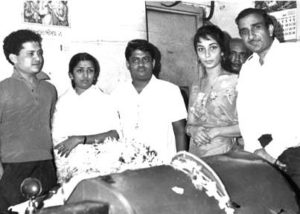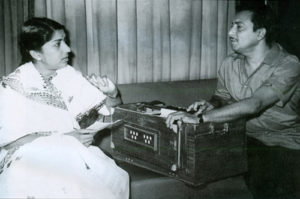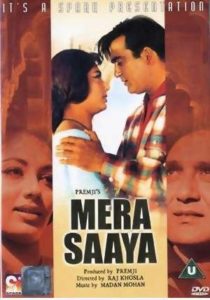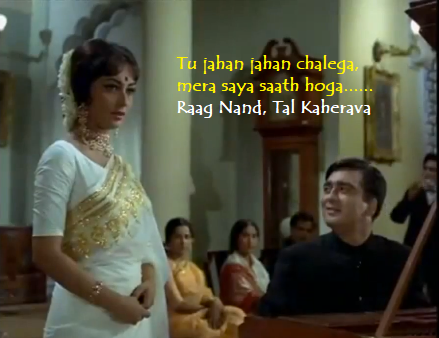Raaga Based Song of the Day: Tu jahan jahan chalega mera saya saath hoga ….
Raag Nand, Tal Kaherava

Some of Lata Mangeshkar’s best songs are picturised on Sadhana. These include: O sajana barkha bahar aayi, Mere mehboob tujhe meri mohabbat ki kasam, Nainon mein badra chhaye, Lag jaa gale ke phir, Naina barse rimjhim rimjhim and Tera mera pyaar amar phir kyun mujhako lagata hai dar. Many of these have been composed by Lata ji’s “Madan bhaiyya”, ie, Madan Mohan. Many of these  are from Raj Khosla movies; he made a triology of suspense movies starring Sadhana: Woh Kaun Thi, Mera Saya and Anita. This one is from his 1966 movie Mera Saya, the title song of the movie. Sadhana had Sunil Dutt opposite her in the movie.
are from Raj Khosla movies; he made a triology of suspense movies starring Sadhana: Woh Kaun Thi, Mera Saya and Anita. This one is from his 1966 movie Mera Saya, the title song of the movie. Sadhana had Sunil Dutt opposite her in the movie.
We have completed seventy-five days of Raaga Based Songs of the Day. Our first post in the series was titled ‘Raaga Based Song Of The Day #1’ and the song was a Mohammad Rafi and Lata Mangeshkar song from the 1970 Shakti Samanta movie Pagla Kahin Ka: Tum mujhe youn bhula na paoge. It is in Raag Jhinjhoti, Tal Kaherava.
Our seventy-fifth post or the last post was titled ‘Raaga Based Song Of The Day #75‘ and the song was a Lata Mangeshkar song from the 1961 Hrishikesh Mukherjee movie Chhaya starring Sunil Dutt, Asha Parekh and Nirupa Roy: Chham chham nachat aayi bahar. It is in Raag Bahar, Tal Tintal, Punjabi Theka, Kaherava.
This blog has a number of posts on Raaga based songs in Hindi movies titled similarly; for example: ‘The Best Raaga Based Songs in Hindi Movies – Raaga Bhairavi – Part II‘.
In the last seventy-five days of sharing Raaga based songs of the day, I have given you songs based on Raag Jhinjhoti, Gara, Bhimpalasi, Madhuvanti, Shivaranjani, Bihag, Pahadi, Sarang, Pilu, Bhairavi, Khammaj, Charukesi, Kalyan or Yaman, Desh, Malgunji, Kirwani, Kedar, Bageshri, Megh Malhar, Bhupali, Ahir Bhairav, Malkaush, Mand, Adana, Kafi, Rageshri, Jaunpuri, Tilang, Janasammohini, Chayanat, Shuddha Kalyan, Gaur Sarang, Jogiya, Asavari, Maru Bihag, Durga, Lalit, Puria Dhanashri, Bhinna Sahdja, Sohani, Multani, Patdeep, Jaijaiwanti, Tilak Kamod, Hemant, Basant Mukhari, Gujri Todi, Kalavati, Hamir, Bhatiyar, Gawati, Shyam Kalyan, Gorakh Kalyan, Madhamat Sarang, Manj Khammaj, Darbari Kanada, Vibhas, Shankara and Bahar; making it a total of 59 raagas. The raagas that have been repeated so far are Pahadi, the raaga of my home place in the Himalayas, Maru Bihag, Raag Kirwani, Jhinjhoti, Bhairavi, Gara, Basant Mukhari, Malkauns and Bhairavi. Today, I am giving you a new Raag Nand. That makes it a total of 60 raagas so far.
Today’s song has been sung by Lata Mangeshkar on the lyrics of Raja Mehdi Ali Khan and composition by Madan Mohan. As I said, it is in Raag Nand, Tal Kaherava.
However, first, lets take up the value added learning of today. Today, we shall learn about list of Hindustani Classical Music Festivals in India and Abroad.
So, now, you are really interested in Indian Classical Music and would like to attend a festival near your place. Here is a list of festivals that are held in India for Hindustani Classical Music (Source: Wikipedia):
| Sl. No. | Festival Name | Ist Yr | Country | State | City |
| 1. | Rajarani Music Festival
(Annual Event) |
India | Odisha | Bhubaneswar | |
| 2. | Qutub Festival | India | Delhi | New Delhi | |
| 3. | Karikan Parameshwari moonlight Sangeeta Festival | India | Karnataka | Honnavar | |
| 4. | Gunidaas Sangeet Samaroh | India | Maharashtra | Mumbai | |
| 5. | Harballabh Sangeet Sammelan | 1875 | India | Punjab | Jalandhar |
| 6. | Tansen Samaroh | 1950s | India | M.P. | Gwalior |
| 7. | Swami Haridas Sangeet Sammelan | 1952 | India | Maharashtra | Mumbai |
| 8. | Dover Lane Music Conference | 1952 | India | West Bengal | Kolkata |
| 9. | Sawai Gandharva Bhimsen Festival | 1953 | India | Maharashtra | Pune |
| 10. | Uttarpada Sangeet Chakra | 1955 | India | West Bengal | Uttarpada |
| 11. | Sabrang Utsav | 1968 | India | Delhi | Delhi |
| 12. | ITC SRA Sangeet Sammelan | 1971 | India | Various | Various |
| 13. | Pandit Motiram Pandit
Maniram Sangeet Samaroh |
1972 | India | A.P. | Hyderabad |
| 14. | Saptak Festival of Music | 1980 | India | Gujarat | Ahmedabad |
| 15. | Ganga Mahotsava | 1985 | India | Various | Varanasi |
| 16. | Nila Festival, Kerala
Kalamandalam |
1986 | India | Kerala | Cheruthuruthy |
| 17. | Pandit Chatur Lal Festival | 1990 | India | New Delhi | Delhi |
| 18. | Sangeet Martand Ustad Chand
Khan Music Festival |
1992 | India | New Delhi | Delhi |
| 19. | Virasat | 1995 | India | Various | Various |
| 20. | Ruhaniyat – The All India Sufi & Mystic Music Festival | 2001 | India | Various | Mumbai/Various |
| 21. | Jahan-e-Khusrau | 2001 | India | New Delhi | Delhi |
| 22. | Sitar in Petersburg | 2008 | Russia | NW District | St. Petersburg |
| 23. | SwaraZankar Music Festival | 2009 | India | Maharashtra | Pune |
| 24. | Riwaayat | 2010 | India | A.P. | Hyderabad |
| 25. | Mahindra Sanatkada Lucknow
Festival |
2010 | India | U.P. | Lucknow |
| 26. | Citi-NCPA Aadi Anant Festival | 2010 | India | Maharashtra | Mumbai |
| 27. | Chaturprahar | 2011 | India | Maharashtra | Mumbai |
| 28. | Sawai Gandharva Bhimsen
Festival, Hyderabad |
2012 | India | A.P. | Hyderabad |
| 29. | Swara Samrat Festival
(One time event) |
2013 | India | West Bengal | Kolkata |
| 30. | Tihai, Shatatantri Media September 18-20 | 2014 | USA | San Francisco | California |
As I said, today’s song is in Raag Nand, Tal Kaherava.
Raag Nand belongs to Kalyan Thaat. Its Jati is Shadhav – Sampurna Vakra (Rishabh Varjya in Aaroha, Both Madhyams. Rest all Shuddha Swaras). Raag Nand is also known as Anandi, Anandi Kalyan or Nand Kalyan. This melody impresses instantly and without any difficulty creates its own unique mood. It is to be performed during the second prahar of the night, ie, 9 PM to Midnight.
I do not know of any other song composed in Raag Nand.

The song Tu jahan jahan chalega mera saya saath hoga is from the 1966 Raj Khosla movie Mera Saya starring Sunil Dutt and Sadhana. The film was inspired by Marathi film called Pathlaag (Chase) but Mera Saaya was remake of Tamil film Idhaya Kamalam.
The movie had beautiful songs penned by Raj Mehdi Ali Khan and composed by Madan Mohan. Besides this, the movie had others:
| 1 | “Jhumka Gira Re” | Asha Bhosle | 03:29 |
| 2 | “Aap Ke Pahloo Mein” | Mohammed Rafi | 03:32 |
| 3 | “Mera Saaya Saath” | Lata Mangeshkar | 06:02 |
| 4 | “Nainon Mein Badra” | Lata Mangeshkar | 03:34 |
| 5 | “Nainon Wali Ne” | Asha Bhosle | 02:56 |
| 6 | “Mera Saaya Saath – 2” | Lata Mangeshkar | 04:21 |
Please enjoy in Raag Nand, Tal Kaherava: Tu jahan jahan chalega, mera saya saath hoga…….
Tuu jahaa.N jahaa.N chalegaa, meraa saayaa, saath hogaa
Meraa saayaa, meraa saayaa
Kabhii mujhako yaad karake, jo bahe.nge tere aa.Nsuu
To vahii.n pe rok le.nge, unhe.n aake mere aa.Nsuu
Tuu jidhar kaa rukh karegaa, meraa saayaa, saath hogaa …
Tuu agar udaas hogaa, to udaas huu.Ngii mai.n bhii
Nazar aauu.N yaa naa aauu.N, tere paas huu.Ngii mai.n bhii
Tuu kahii.n bhii jaa rahegaa, meraa saayaa, saath hogaa …
Mai.n agar bichha.D bhii jaauu.N, kabhii meraa Gam na karanaa
Meraa pyaar yaad karake, kabhii aa.Nkh nam na karanaa
Tuu jo mu.Dake dekh legaa, meraa saayaa, saath hogaa …
Meraa Gam rahaa hai shaamil, tere dukh me.n, tere Gam me.n
Mere pyaar ne diyaa hai, teraa saath har janam me.n
Tuu koI janam bhii legaa, meraa saayaa saath hogaa …
https://www.youtube.com/watch?v=-9ENm1Frqxc
We have intended to learn about Raaga based music whilst we entertain ourselves with Raaga based songs. So, lets, once again, take stock of our collective learning so far:
- On the first day we learnt about the Raaga system devised by Pandit Vishnu Narayan Bhatkhande, which is the prevalent system in Hindustani Classical Music and based on ten Thaats.
- On the second day we learnt about Tal or Taal.
- On the third day we learnt about characteristics of Raagas that included Swar, Jati, Thaat, Arohana and Avarohana, Vadi, Samvadi and Pakad.
- On the fourth day, we learnt about Sargam.
- On the fifth day, we learnt about notations used in Indian classical music or simply Swar Lipi.
- On the sixth day, we learnt about the Ras (sentiments) that Raagas evoke.
- On the seventh day, we learnt about various types of Swar: Shuddha, Achal, Vikrut, Komal and Teevra.
- On the eighth day, we learnt the parts of a composition in Indian Classical Music.
- On the ninth day, we learnt the names of some of the popular instruments used in Indian Classical Music.
- On the tenth day, we learnt about the sources of names of Raagas.
- On the eleventh day, we learnt about why Bhairavi is the first raag to be taught to beginners and also why it is the last in a performance.
- On the twelfth day, we learnt about Khammaj Thaat.
- On the thirteenth day, we learnt about Tal Punjabi Theka or Sitarkhani.
- On the fourteenth day, we learnt about Alap.
- On the fifteenth day, we learnt about List of Raagas (Raagmala) in my favourite book: Sri Guru Granth Sahib.
- On the sixteenth day, we learnt about tips for raaga identification.
- On the seventeenth day, we learnt the basics of Gharana system.
- On the eighteenth day, we learnt about Filmi Sangeet.
- On the nineteenth day, we learnt about the commonest Tal in Raagas: Tintal.
- On the twentieth day, we learnt about the Kafi Thaat.
- On the twenty-first day, we learnt a little more in detail about the classification of Raagas.
- On the twenty-second day, we learnt the essential differences between Bhairavi and Bhairav.
- On the twenty-third day, we learnt a little more in detail about the Jati or Jaati of a raaga.
- On the twenty-fourth day, we learnt details of Thaat Bilawal, the most basic thaat in the Bhatkhande’s system of raagas.
- On the twenty-fifth day, we learnt about Tintal.
- On the twenty-sixth day, we learnt in detail about the Raaga – Samay linkage.
- On the twenty-seventh day, we learnt about Lehar.
- On the twenty-eighth day, we learnt about the history of the Hindustani Music.
- On the twenty-ninth day, we learnt about Dhrupad.
- On the thirtieth day, we learnt about Rupaktal that I was introduced to, a few months back, by my friend Anand Desai.
- On the thirty-first day, we learnt about Khayal.
- On the thirty-second day, we learnt about Thumri.
- On the thirty-third day, we learnt about Tappa.
- On the thirty-fourth day, we learnt about Tarana.
- On the thirty-fifth day, we learnt about Tal Dipchandi (Moghali).
- On the thirty-sixth day, we learnt about Tabla.
- On the thirty-seventh day, we learnt about Kirtan.
- On the thirty-eighth day, we learnt about Pakhawaj.
- On the thirty-ninth day, we learnt about Hori.
- On the fortieth day, we learnt about Dadra.
- On the forty-first day, we learnt about Kajri.
- On the forty-second day, we learnt about Chaiti.
- On the forty-third day, we learnt about Sarangi.
- On the forty-fourth day, we learnt about Shehnai.
- On the forty-fifth day, we learnt about Sarod.
- On the forty-sixth day, we learnt about Bansuri.
- On the forty-seventh day, we learnt about Ektal and Tanpura.
- On the forty-eighth day, we learnt about Veena.
- On the forty-ninth day, we repeated our learning of Veena with a small excitement added.
- On the fiftieth day, we learnt about Dilruba/Esraj.
- On the fifty-first day, we learnt about Jaltarang.
- On the fifty-second day we learnt about Qawwali.
- On the fifty-third day, we learnt about Sitar.
- On the fifty-fourth day, we learnt about Surbahar.
- On the fifty-fifth day, we learnt about Harmonium.
- On the fifty-sixth day, we learnt about Santoor.
- On the fifty-seventh day, we learnt about Swarmandal.
- On the fifty-eighth day, we learnt about the Shruti Box.
- On the fifty-ninth day, we learnt about Alankar.
- On the sixtieth day, we learnt about singing in Aakaar.
- On the sixty-first day, we learnt about the Classification of Indian Musical Instruments.
- On the sixty-second day, we learnt a little about Carnatic Music.
- On the sixty-third day, we learnt about Natya Shastra.
- On the sixty-fourth day, we learnt about evolution of musical instruments in India down the ages.
- On the sixty-fifth day, we learnt about Riyaaz.
- On the sixty-sixth day, we looked at a list of Raagas in Hindustani Classical Music.
- On the sixty-seventh day, we learnt about the health benefits of raagas.
- On the sixty-eighth day, we learnt a little more comprehensively about the moods and emotions that raagas evoke.
- On the sixty-ninth day, we learnt about a mobile application to help identify raagas.
- On the seventieth day, we learnt about Melakarta Raagas.
- On the seventy-first day, we learnt about Sangita Makarand.
- On the seventy-second day, we learnt about TaalMala an Android application for personalized accompaniment of musical instruments during Riyaaz or even during Concert.
- On the seventy-third day, we learnt about Indian Classical Ragas, an Android application for mobile phones.
- On the seventy-fourth day, we learnt about Saregama Classical, another application for Classical Raagas.
- On the seventy-fifth day, we learnt about a free online service available to learn Indian Classical Music.
- And today, on the seventy-sixth day, we learnt about List of Hindustani Classical Musical Festivals in India and Abroad.
There is much more still to be learnt and enjoyed.
Please stay tuned!
